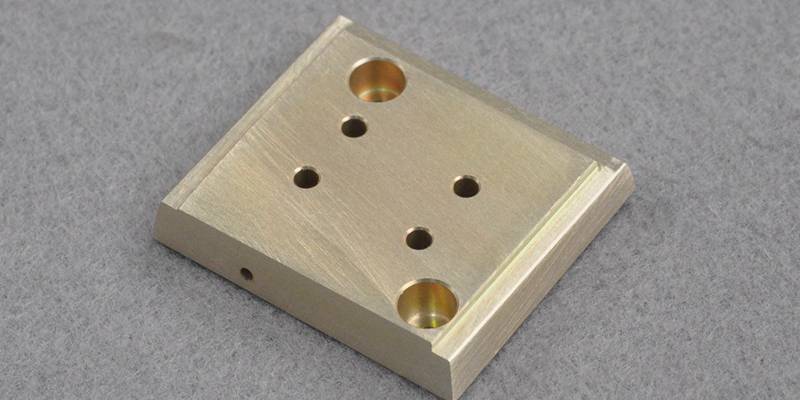- June 24, 2022
Surface finishing in the manufacturing industry improves a product’s functionality and aesthetics and enhances other attributes. For example, it is suitable for protecting products from corrosion, abrasion, etc. Among the several processes used by different manufacturers, alodine finish has unique properties as the surface finishing option boasts incredible productivity, ease of operation, longevity, etc.
Here, we will introduce you to everything you need about Alodine finishing. This will include the principle, applications, design considerations, and other things that make it one of the best surface finishing options you can think of for your product.
What is Alodine?
Alodine is a chemical substance dissolved in aqueous solutions to produce a gel applied to metals such as aluminum alloys. It forms a coating that protects the metals and enhances their aesthetic appeal. Other functions of alodine finish include:
-Act as a base for painting and priming
-Helps in preserving electrical conductivity.
However, the name “Alodine” has been trademarked by Henkel Surface Technology. The generic name for this type of chem film is “chromate conversion coating”.
How Does Alodine Finish Work?
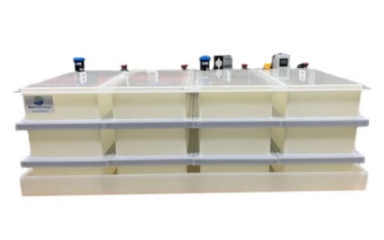
Alodine or chromate conversion coating is a simple process that leads to passivation. The process is straightforward. However, it depends on the alodine you are working with.
Type 1 Chromating Process
If you are using the Type 1 MIL-DTL-5541 standard, follow the steps below to apply alodine chemical conversion coatings on your metal parts.
Step #1: Clean the Metal Product
Degrease the first part to eliminate small impurities such as oxides, greases, oil, and heavy metal contaminant. After degreasing, rinse the part and dry it. Degreasing the product ensures that the chemical conversion coating sticks well and is even.
Step #2: Etch the Product
Etch the part of the metal product where you don’t want the chemical conversion coatings to be. Etching will cover these areas so that you can correctly and accurately coat the metal product. Rinse and dry the product again.
Step #3: Deoxidize
Oxygen is another contaminant you should avoid in alodine coating or other chemical conversion coatings. Remove oxygen by putting the part through a deoxidization process. This will remove oxygen, oxides, and other related chemicals. Rinse the part to remove the deoxidizing agent.
Step #4: Apply Chem Film Coat
Immerse the part in a chemical bath containing the alodine compound dissolved in an aqueous solution for a predetermined time. The time chosen depends on the part and the thickness desired. You can also use a brush or spray the part with the alodine.
Step #5: Final Wash
After applying the alodine chemical conversion coatings, rinse with water to remove the excessive coating. Then rinse with warm water to get a perfect surface finish. Allow the part to dry.
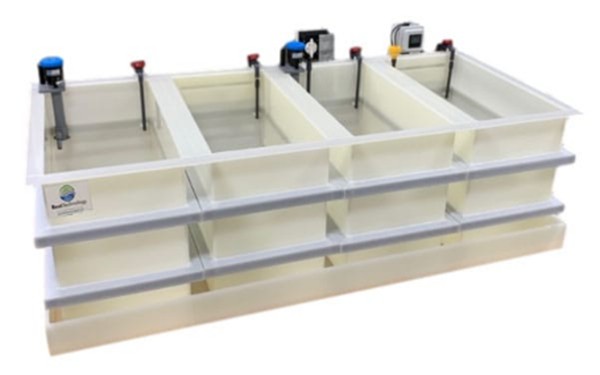
Type 2 Chromating Process
The Type 2 MIL-DTL-5541 standard is slightly different and has two variations: Acid clean and Alkaline clean process. Follow the steps below on applying the alodine finish on the part.
Acid Clean Process
- Clean the product using acid
- Rinse with water
- Apply the Type 2 alodine
Alkaline Clean Process
- Clean the product using an alkaline solution
- Rinse with water
- Deoxidize to remove oxygen contaminant
- Rinse with water
- Apply the Type 2 alodine
Types of Alodine Chromate Conversion Coating
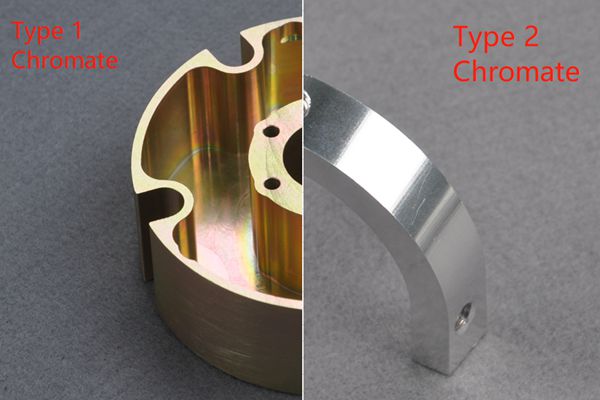
There are several types of alodine, each with unique chemical composition. Common ones include Type 1 and Type 2 of the MIL-DTL-5541 standard, AMS-C-5541, MIL-C-81706, and AMS-2473 and 2474.
Of the five above, the two most typical ones in the manufacturing world are:
MIL-DTL-5541 Standard (TYPE I)
Type 1 MIL-DTL-5541 standard contains hexavalent chromium that produces a brown or gold film or sometimes a clear film. Also known as hex chrome due to the presence of hexavalent chromium, it was the conventional alodine for many years until the advent of Type 2 and other safer chemicals.
Hexavalent chromium is a hazardous chemical labeled by OSHA as carcinogenic. Therefore, some countries do not permit its use. Those that permit its use require processing permits, proper ventilation, and disposal method.
MIL-DTL-5541 Standard (TYPE II)
MIL-DTL-5541 Type 2 is the standard alodine in the world. Unlike Type 1, it contains trivalent chromium, titanium, or zirconium. Therefore, it is referred to as hex-free chrome. Also, Type 1 does not come in color as parts subjected to the coating are clear. Type 2 has the following advantages over type 1
- It has a better safety profile
- It occurs at a lower temperature than Type 1
- The application process is easier, faster, and a more straightforward
Alodine vs. Anodizing: What's the Difference
Both alodine and anodizing are conversion coating processes and are sometimes confused with each other due to their similar production process. They involve immersing the part in chemicals and allowing the coatings to form. However, both surface finishes are different. Below are a few differences between both processes.
Process
The difference between alodine and anodizing becomes clearer by understanding the processes themselves. Anodizing is an electrolytic process that involves coating a metal with its oxide. For example, anodizing aluminum makes the part more corrosion and wear-resistant. This is different from chromate conversion coatings, a simple chemical process that doesn’t use electrical currents.
Effect
The effect of the alodine finish on the metal part dimension is very small, with thickness between 0.00001 to 0.00004 inches. This is unlike the anodizing that forms a thicker layer (ranging from 0.00001 in Type 1 anodizing to 0.001 in Type III anodizing.)
Purpose
Both conversion coating methods are suitable for achieving corrosion resistance. However, anodizing has a better aesthetic appeal. Hence it is more suitable for decorative purposes.
Cost
Alodine finish is less costly than anodizing. However, you should factor in the different types of alodine, the size of the metals, and other implications as they can also impact the price.
What are the Characteristics of Alodine Finish
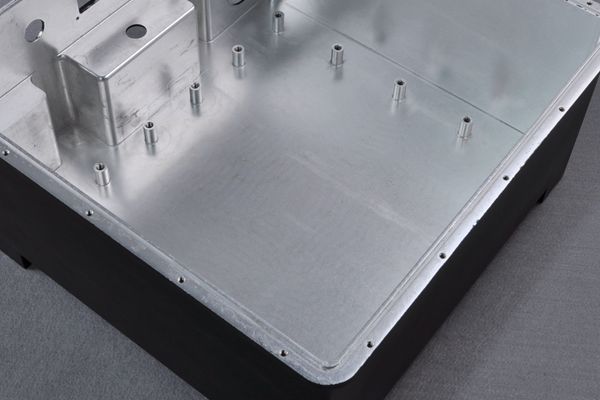
Alodine finish is a common industrial surface finish process due to its simplicity without a loss of function. Below are a few characteristics that make it one of the best to consider.
Thin film
One of the unique things about the alodine finish is the formed coating film. This is beacuse the coating film is very thin, usually between 0.5 and 4 microns. It can act as a corrosion-resistant surface, primer, or base without altering the part dimension
Application at room temperature
Applying the chromate conversion coating, especially Type 2 standard, can occur at room temperature. Therefore, manufacturers and designers don’t need to stress over applying the coating. Also, it reduces the energy consumed, reducing the cost of acquiring such energy.
Alodine solution is toxic
The type of alodine you are using will determine the toxicity. The hex chrome is very toxic and considered by OSHA a carcinogenic material. However, the hex-free chrome is not toxic. Nevertheless, handle both with care and dispose of them using the stipulated regulations according to government bodies.
Fast application process
Applying the chem film onto a metal part should only take a few minutes. However, this depends on the method you are using.
Great conductive surface
Aside from making the metal corrosion-resistant, an alodine finish also makes the metal conductive. Parts subjected to the process are also useful as a base for priming and paints.
Applications of Alodine Finish
Alodine finishing is widely applicable in several industries in the manufacturing world. Below are a few applications of the surface finishing option.
CNC precision machining parts
One of the most common alodine coatings applications is the surface treatment of CNC precision machining parts. CNC fabricated metal parts are preserved from corrosion and surface-acting contaminants with alodine coatings. What makes alodine ideal is that there is no significant alteration to the final dimension of the metal parts.
Aerospace industry
As a result, alodine coating is an important surface finishing as it protects aluminum alloys and other materials used in the aerospace industry. Parts used in making aerospace parts, such as aircraft hulls, landing gear, shock absorbers, etc., are exposed to atmospheric gases at high altitudes. This can lead to the corrosion of such parts.
Military and Defense industry
Parts used in making products used in the military and defense industry must resist corrosion. For example, boat interiors and other mechanical parts in the navy are often invaded by salt water, thereby susceptible to corrosion. Therefore, alodine coatings protect aluminum and other important materials.
Design Considerations: How to Make Alodine Finish Looks Good
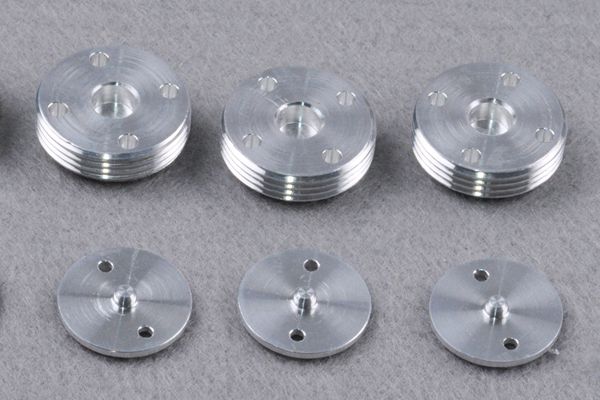
Chromate conversion coating is a very straightforward process. However, you need a few design considerations to make the alodine finish look good. Below are a few design considerations to consider:
-Plugging threaded/reamed holes
This might be needed if tolerance is very tight. However, most manufacturers shouldn’t consider it as chromate conversion coatings’ thickness change is minimal.
-Deburring
You can improve the consistency of the coating by deburring the surface. Deburring will remove or hide small machine marks on the parts, making the surface smoother and the finishing of better quality.
-PH and temperature
Ensure you are using the alodine finish at the right pH and Temperature specified in the specifications. Using them otherwise would lead to non-adhering coatings.
-Bad alodine material
Using the wrong alodine finish can also affect the quality of the product. Therefore, ensure you don’t have a bad can of material. You can ascertain this by asking the manufacturers for the QC sample and checking whether they meet your specifications. You can also ask for a test service.
Conclusion
In conclusion, among the different surface finishing procedures used by different manufacturers, alodine finishing boasts incredible productivity, ease of operation, and quality product.
Most importantly, the process involves coating the metal part to protect it from corrosion, act as a base or primer, and improve its electrical conductivity. Chromate conversion coating has many applications due to its thin coating, which is ideal for coating precision parts.
So, if you are looking for a chromate conversion coating for your machined parts, WayKen is the right company to meet your alodine finish needs with high standards. Meanwhile, we can make sure your all products are properly surface finished and look great.
FAQs
What is an Alodine finish?
Alodine or chromate conversion coating is used for metal corrosion protection. It also acts as a base, primer, or for presenting the metal’s electrical conductivity.
How do you apply Alodine Chromate coating?
There are different styles of applying alodine. You can brush, dip/immerse, or spray the coating on the metal part. Of the different styles, immersion is the most common.
Is it Alodine finish important for CNC machined parts?
Yes, CNC machined parts must be precise even though subjected to any surface finishing option. Of the different surface finishing options available. Chromate conversion coating is a surface treatment that can help with corrosion protection without altering the metal part’s dimension. It also helps reduces poor electrical resistance.
How thick is chromate conversion coating?
The chromate coating thickness ranges from 0.25-1.0 µm or 0.00001-0.00004 inches.

